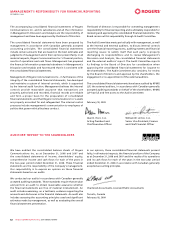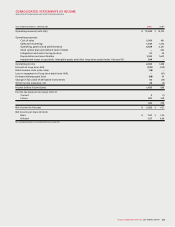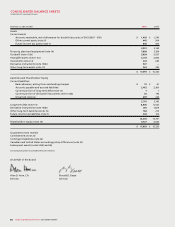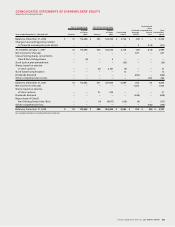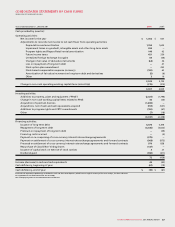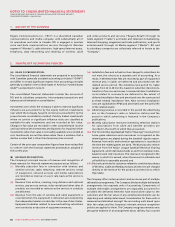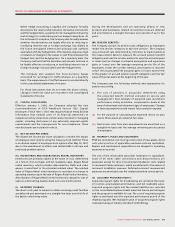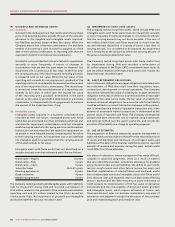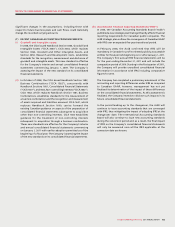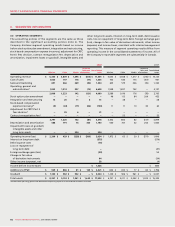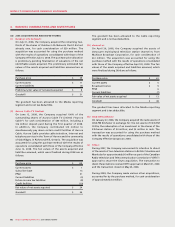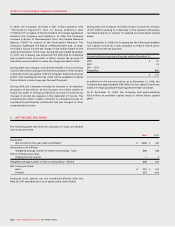Rogers 2008 Annual Report Download - page 94
Download and view the complete annual report
Please find page 94 of the 2008 Rogers annual report below. You can navigate through the pages in the report by either clicking on the pages listed below, or by using the keyword search tool below to find specific information within the annual report.
90 ROGERS COMMUNICATIONS INC. 2008 ANNUAL REPORT
NOTES TO CONSOLIDATED FINANCIAL STATEMENTS
(H) FINANCIAL AND DERIVATIVE INSTRUMENTS:
(i) Adoption of new financial instruments standards:
On January 1, 2008, the Company adopted The Canadian
Institute of Chartered Accountants’ (“CICA”) Handbook
Section 3862, Financial Instruments – Disclosures (“CICA 3862”),
and CICA Handbook Section 3863, Financial Instruments –
Presentation (“CICA 3863”).
CICA 3862 requires entities to provide disclosures in their
financial statements that enable users to evaluate the
significance of financial instruments on the entity’s financial
position and its performance and the nature and extent of
risks arising from financial instruments to which the entity is
exposed during the year and at the balance sheet date, and
how the entity manages those risks.
CICA 3863 establishes standards for presentation of financial
instruments and non-financial derivatives. It deals with the
classification of financial instruments, from the perspective of
the issuer, between liabilities and equities, the classification of
related interest, dividends, gains and losses, and circumstances
in which financial assets and financial liabilities are offset.
The adoption of these standards did not have any impact on
the classification and measurement of the Company’s financial
instruments. The new disclosures pursuant to these new
Handbook Sections are included in note 15.
(ii) Financial instruments:
On January 1, 2007, the Company adopted CICA Handbook
Section 3855, Financial Instruments – Recognition and
Measurement, Handbook Section 1530, Comprehensive
Income, Handbook Section 3251, Equity, and Handbook
Section 3865, Hedges, retrospectively without restatement.
The impact of the adoption of these standards on opening
accumulated other comprehensive income and on opening
deficit at January 1, 2007 was as follows:
The Company’s financial assets are classified as available-for-
sale or loans and receivables. Available-for-sale investments
are carried at fair value on the balance sheet, with changes
in fair value recorded in other comprehensive income, until
such time as the investments are disposed of or an other-
than-temporary impairment has occurred, in which case the
impairment is recorded in income. Loans and receivables and
all financial liabilities are carried at amortized cost using the
effective interest method. The Company determined that none
of its financial assets are classified as held-for-trading or held-
to-maturity and none of its financial liabilities are classified as
held-for-trading.
The Company records all transaction costs for financial assets
and financial liabilities in the consolidated statements of
income as incurred.
(iii) Derivative instruments:
All derivatives, including embedded derivatives that must be
separately accounted for, are measured at fair value, with
changes in fair value recorded in the consolidated statements
of income unless they are effective cash flow hedging
instruments. The fair value of the Company’s cross-currency
interest rate exchange agreements (“Cross-Currency Swaps”)
is determined using an estimated credit-adjusted mark-to-
market valuation which involves increasing the treasury-related
discount rates used to calculate the risk-free estimated
mark-to-market valuation by an estimated credit default swap
spread (“CDS Spread”) for the relevant term and counterparty
for each Cross-Currency Swap. In the case of Cross-Currency
Swaps in an asset position (i.e., those Cross-Currency Swaps for
which the counterparties owe the Company on a net basis),
the CDS Spread for the bank counterparty is added to the risk-
free discount rate to determine the estimated credit-adjusted
value. In the case of Cross-Currency Swaps in a liability position
(i.e., those Cross-Currency Swaps for which the Company
owes the counterparties on a net basis), the Company’s CDS
Spread is added to the risk-free discount rate. The changes
in fair value of cash flow hedging derivatives are recorded in
other comprehensive income, to the extent effective, until the
variability of cash flows relating to the hedged asset or liability
is recognized in the consolidated statements of income.
Any hedge ineffectiveness is recognized in the consolidated
statements of income immediately.
The Company uses derivative financial instruments to manage
risks from fluctuations in exchange rates and interest rates.
From time-to-time, these instruments include Cross-Currency
Swaps, interest rate exchange agreements, foreign exchange
forward contracts and, foreign exchange option agreements.
All such instruments are only used for risk management
purposes.
Impact
upon Income tax Net
adoption impact impact
Available-for-sale investments $ 213 $ (2) $ 211
Derivative instruments (561) 136 (425)
Opening accumulated other comprehensive income $ (348) $ 134 $ (214)
Ineffective portion of hedging derivatives $ (10) $ 2 $ (8)
Early repayment option 19 (6) 13
Deferred transitional gain 54 (17) 37
Transaction costs (59) 20 (39)
Opening deficit $ 4 $ (1) $ 3




